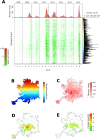Spatio-temporal coherence of dengue, chikungunya and Zika outbreaks in Merida, Mexico
- PMID: 29543910
- PMCID: PMC5870998
- DOI: 10.1371/journal.pntd.0006298
Spatio-temporal coherence of dengue, chikungunya and Zika outbreaks in Merida, Mexico
Abstract
Response to Zika virus (ZIKV) invasion in Brazil lagged a year from its estimated February 2014 introduction, and was triggered by the occurrence of severe congenital malformations. Dengue (DENV) and chikungunya (CHIKV) invasions tend to show similar response lags. We analyzed geo-coded symptomatic case reports from the city of Merida, Mexico, with the goal of assessing the utility of historical DENV data to infer CHIKV and ZIKV introduction and propagation. About 42% of the 40,028 DENV cases reported during 2008-2015 clustered in 27% of the city, and these clustering areas were where the first CHIKV and ZIKV cases were reported in 2015 and 2016, respectively. Furthermore, the three viruses had significant agreement in their spatio-temporal distribution (Kendall W>0.63; p<0.01). Longitudinal DENV data generated patterns indicative of the resulting introduction and transmission patterns of CHIKV and ZIKV, leading to important insights for the surveillance and targeted control to emerging Aedes-borne viruses.
Conflict of interest statement
The authors have declared that no competing interests exist.
Figures



Similar articles
-
Vector competence of Aedes aegypti from Havana, Cuba, for dengue virus type 1, chikungunya, and Zika viruses.PLoS Negl Trop Dis. 2020 Dec 3;14(12):e0008941. doi: 10.1371/journal.pntd.0008941. eCollection 2020 Dec. PLoS Negl Trop Dis. 2020. PMID: 33270652 Free PMC article.
-
Spatiotemporal transmission dynamics of co-circulating dengue, Zika, and chikungunya viruses in Fortaleza, Brazil: 2011-2017.PLoS Negl Trop Dis. 2020 Oct 26;14(10):e0008760. doi: 10.1371/journal.pntd.0008760. eCollection 2020 Oct. PLoS Negl Trop Dis. 2020. PMID: 33104708 Free PMC article.
-
Experimental Zika virus infection in Aedes aegypti: Susceptibility, transmission & co-infection with dengue & chikungunya viruses.Indian J Med Res. 2018 Jan;147(1):88-96. doi: 10.4103/ijmr.IJMR_1142_17. Indian J Med Res. 2018. PMID: 29749366 Free PMC article.
-
The worldwide seroprevalence of DENV, CHIKV and ZIKV infection: A systematic review and meta-analysis.PLoS Negl Trop Dis. 2021 Apr 28;15(4):e0009337. doi: 10.1371/journal.pntd.0009337. eCollection 2021 Apr. PLoS Negl Trop Dis. 2021. PMID: 33909610 Free PMC article.
-
Aedes vittatus (Bigot) mosquito: An emerging threat to public health.J Vector Borne Dis. 2017 Oct-Dec;54(4):295-300. doi: 10.4103/0972-9062.225833. J Vector Borne Dis. 2017. PMID: 29460858 Review.
Cited by
-
Overlap between dengue, Zika and chikungunya hotspots in the city of Rio de Janeiro.PLoS One. 2022 Sep 6;17(9):e0273980. doi: 10.1371/journal.pone.0273980. eCollection 2022. PLoS One. 2022. PMID: 36067192 Free PMC article.
-
First report of Aedes albopictus infected by Dengue and Zika virus in a rural outbreak in Brazil.PLoS One. 2020 Mar 12;15(3):e0229847. doi: 10.1371/journal.pone.0229847. eCollection 2020. PLoS One. 2020. PMID: 32163449 Free PMC article.
-
Efficacy of targeted indoor residual spraying with the pyrrole insecticide chlorfenapyr against pyrethroid-resistant Aedes aegypti.PLoS Negl Trop Dis. 2021 Oct 4;15(10):e0009822. doi: 10.1371/journal.pntd.0009822. eCollection 2021 Oct. PLoS Negl Trop Dis. 2021. PMID: 34606519 Free PMC article.
-
Spatio-temporal clusters and patterns of spread of dengue, chikungunya, and Zika in Colombia.PLoS Negl Trop Dis. 2022 Aug 23;16(8):e0010334. doi: 10.1371/journal.pntd.0010334. eCollection 2022 Aug. PLoS Negl Trop Dis. 2022. PMID: 35998165 Free PMC article.
-
The entomological impact of passive metofluthrin emanators against indoor Aedes aegypti: A randomized field trial.PLoS Negl Trop Dis. 2021 Jan 26;15(1):e0009036. doi: 10.1371/journal.pntd.0009036. eCollection 2021 Jan. PLoS Negl Trop Dis. 2021. PMID: 33497375 Free PMC article. Clinical Trial.
References
-
- Jones KE, Patel NG, Levy MA, Storeygard A, Balk D, et al. (2008) Global trends in emerging infectious diseases. Nature 451: 990–993. doi: 10.1038/nature06536 - DOI - PMC - PubMed
-
- Morens DM, Fauci AS (2013) Emerging infectious diseases: threats to human health and global stability. PLoS Pathog 9: e1003467 doi: 10.1371/journal.ppat.1003467 - DOI - PMC - PubMed
-
- Kieny MP, Salama P WHO R&D Blueprint: a global coordination mechanism for R&D preparedness. The Lancet 389: 2469–2470. - PubMed
-
- Musso D, Gubler DJ (2016) Zika Virus. Clin Microbiol Rev 29: 487–524. doi: 10.1128/CMR.00072-15 - DOI - PMC - PubMed
-
- Zhang Q, Sun K, Chinazzi M, Pastore YPA, Dean NE, et al. (2017) Spread of Zika virus in the Americas. Proc Natl Acad Sci U S A 114: E4334–E4343. doi: 10.1073/pnas.1620161114 - DOI - PMC - PubMed
Publication types
MeSH terms
Grants and funding
LinkOut - more resources
Full Text Sources
Other Literature Sources
Medical

